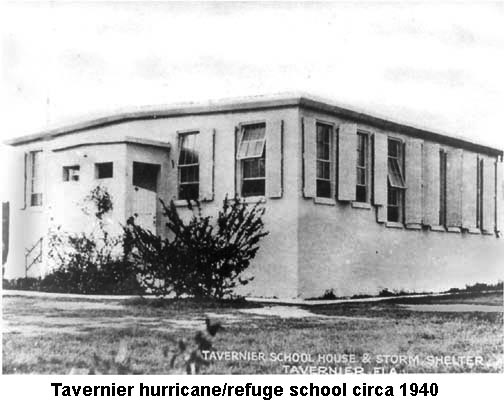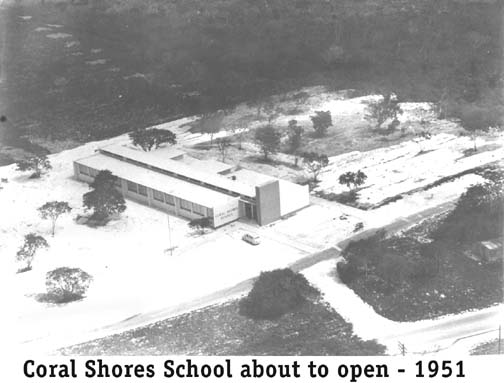|
In 1928, the name was changed to The Florida Branch of National Congress of Parents and Teachers, Inc., to be changed again in 1933 to The Florida Congress of Parents and Teachers, Inc. The first real estate subdivision plotted on Key Largo was known as the North Carolina Fishing Camp, near Newport in 1924. The following year, State Road 4A construction began using a rickety wooden bridge across Card Sound and the development of Key Largo was on, but not with any blinding speed. So, for how long would these one and two-room schools be adequate? The Great Depression of the 1930s slowed development to almost a standstill, and the apparent need for education grew slowly. The World War I veterans who were building the bridge from Lower Matecumbe to Jewfish Bush Key had a monthly newspaper, The Key Veteran News. The August 31, 1935 issue carried on the front page, "Veterans To Build School House Here." The “here” was Islamorada and it was to be a 113 by 83-foot structure across the old highway from the post office. The school was to accommodate students from Tavernier to Lower Matecumbe. As if the depression were not enough, two days later the 1935 hurricane left only the Rock Harbor school and a small school building at Tavernier standing and they were damaged. To recover from the killer hurricane, the Islamorada-Matecumbe school classes were offered in the present two-story Grove Park (the name may change from time to time) wooden building constructed by Eddie Sweeting. Today's concrete portion of the Islamorada Library was then built by the WPA as a hurricane refuge-school. The Rock Harbor Grammar School remained in the present Moose Lodge building and received Tavernier's students. The Tavernier school had been in a lime-packing shed that was also destroyed by the hurricane. Tavernier's students doubled up at the Rock Harbor school until a small school could be constructed on the Roger Albury at Tavernier. In 1939, the Rock Harbor and Tavernier schools were combined into another hurricane refuge school built in Tavernier. The Matecumbe and Tavernier hurricane refuge-school were built from the same plans and concurrently. Note, these schools now offered education through the 10th grade, and some time offered the 11th grade with approval od the Board of Public Instruction. The WPA did all the infrastructure work and Monroe County provided all the equipment and furnishings. The Tavernier refuge school is presently the Monroe County Health Department and Matecumbe is the Islamorada Library. Later, at Tavernier a portable building was installed to support the increased student demand and Ed Tomerlin was added to the teaching staff.  For more details
of the two WPA built concrete schools Click Here. For more details
of the two WPA built concrete schools Click Here.For an idea of population involved, the 1940 census showed Key West with a population of 12,927 and the Upper Keys with a total of 352. The addition of public water, electricity and improved highway increased the Upper Keys population drastically. Continuing to set the stage for Coral Shores High School, Charles "Prof" Albury moved from Marathon in 1930 to teach, along with Ferran Pinder, in the early Matecumbe school located on the beach. After the 1935 hurricane and with the consolidation of the Rock Harbor and Tavernier schools in 1939, "Prof" and Harold Russell taught at the Tavernier school. Rock Harbor driver John A. Curry bused the students to Tavernier. Later Violet Albury took Harold's teaching position. Ferran Pinder continued to teach in the Islamorada school with the help of Virginia Shine, Catherine Albury, and later Babs Petsinger. "Prof" Albury was hired to teach grades 5-10, but voluntarily taught grade 11 (sometimes without pay) to prepare those desiring a diploma. Often the 10th and 11th grades had to be taught at night, as the daytime load was too great. To obtain a high school diploma, everyone had to transfer to Key West, Homestead, or Miami for grade 12 and graduation. With the installation of public electricity and water in 1942, the population of the Upper Keys grew from 352 in 1940 to 1,025 in 1950, and the little two-room schools were excessively overcrowded. The Florida Keys Weekly News (FKWN) reported enrollments in October, 1947 as: Tavernier 65, Matecumbe 45 and Marathon 60. Quoting from the FKWN addressing the Tavernier School in 1947, ". . . Eight are now having to share a table, sitting upon hard wooden chairs that will hardly do justice in getting the best efforts of a students capabilities." In 1948, the communities got together and spearheaded by PTA President "K" Wilkinson of Tavernier, petitioned the School Board for a high school. The School Board obtained an offer of 16 acres of high ground from Mrs. P. L. Wilson for $5,800. In September 1949, the board proposed a school bond issue for $500,000 -enough to include a Consolidated Plantation Key School. Election day was a rainy day, so "K" and the supporters went house-to-house and transported voters to the polls in their personal cars. At one house, the man was taking a shower and Miss "K" said, "We'll wait." The school bond issue was approved. Horace O'Bryant, Superintendent of Public Instruction of Monroe County, told the citizens of the Upper Keys to submit names to be selected for the new school. Student Sally Jinette of Greyhound Key submitted the name of "Coral Shores," which was chosen the winner.  Plantation Key, became the school site and in 1951, the Coral Shores School opened the "A" wing with six classrooms and six teachers for grades 1 through 11. The old Tavernier and Matecumbe schools were closed and "Prof" Albury moved to Coral Shores as its principal. Ferran Pinder from Matecumbe was his assistant. In those days these were working positions. "Uncle" Ferran taught biology, chemistry and mechanical drawing. "Prof" filled in wherever needed, even as janitor. The following year, grade 12 was added and the school was formally dedicated as Coral Shores High School in 1952. The old Tavernier school building became the first doctor's clinic in 1953. Coral Shores experienced a serious flu epidemic the first week of March 1953 when more than a third of the students were out with the illness. School was suspended and records indicate this has never occurred again. The first class of 14 students graduated on June 10, 1953. Of the 13 graduates, Shirley Faye Albury and Buddy Martin were the only ones who had gone through all 12 grades "down in the Keys." This first graduating student class initiated the yearbook titled "The Reef," which has continued to the present. For only 13 students it made for a busy year. Sally Jinette was valedictorian and Venetia Felton was salutatorian. Student government, dramatics club, glee club, student council, a newspaper and sports program were added. Ed Tomerlin headed the athletic program and taught math as well. The program season started with the traditional football game of Greens versus Golds (seniors) and the Golds won. Volleyball and baseball followed football. In September 1955, a one-room house was moved to Newport to serve the Black population. Originally, a new school building was supposed to be constructed. The process was however not without a few problems. The Florida Keys News reported in its April 28, 1955 edition, "A petition is being circulated in Key Largo, relative to relocating the site for the new Negro School to be built in that area. The petition asks for a change of the location from the site orginally selected. It is pointed out that property values are too high at this spot to be used for this purpose and to locate the school on property of less commercial value." A used house was moved to the Newport property. This became the Burlington Grammar School (grades 1 to 9) and was in front of where the Key Largo Mosquito Control building is now at about MM 101, oceanside. Clarence "Pop" Alexander and his wife Lucienda helped petition for the moving of the little one-room house to that location from Tavernier. Key Largo's first black fire chief, Harry Davis Jr., was one of the first students, but lived with relatives in Homestead to continue school and graduate. In February 1965, Monroe County ordered integration of all its schools. Burlington School was closed and its students transferred to Coral Shores. Andrew Fowler was the first black Coral Shores graduate in 1966. One paragraph about Key West. Its first high school was the Sears High School and its first graduate was Lance Lester in 1909, father of Judge Ignatius Lester. Later, our County Mayor Wilhelmina Harvey taught high school in Key West. She tells of one summer she had gone to Tulane college for a physics course and rushed back home for the start of the school year. When she arrived in Miami by train and asked, "What time does the next train leave for Key West?" She was told that there would be no train to Key West. The date was September 3, 1935, the day after the fatal Labor Day hurricane. When Coral Shores High School opened, Marathon had no high school. Marathon transported its students either to Key West or to Greyhound Key (now Fiesta Key) to be shuttled to Coral Shores by bus. Evenette (Pinder) Stone, of Islamorada, drove a school bus for 28 years and remembers picking up the Marathon students on U.S. 1. She turned around using the road to the Goetz's house (Fiesta Key) until 1958, when Marathon High School opened. Don Moore was the first Marathon student to graduate from Coral Shores in 1955. As previously stated, in 1940 the population of the Upper Keys was 352 and increased to 1,025 in 1950. It tripled again by 1960 to 3,125 with the addition of a high school. Coral Shores added the B wing in 1954 and the D and E wings with a shop and cafeteria in 1957. After teaching for 34 years in the Upper Keys, "Prof" Albury retired as principal in 1965. Assistant principal Edd Adair became the principal. Edd took a year's absence in 1972 for post-graduate studies and Roger Allen assumed the role as principal for that year. Michael Lannon became principal of Coral Shores in August, 1975. Grades K through 7 were moved to the newly opened Plantation Key School on October 18, 1976 with Edd Adair as their principal. Key Largo had to struggle to get its grammar school open. Originally scheduled to open in 1971, the building was not ready for the August opening. Newly assigned principal Dr. Caputo opened the school in 1971 with classrooms in the Plantation Key San Pedro Church (kindergarten), Tavernier Burton Methodist Church (grade 2), Key Largo Lions Den (grade 3), Key Largo Civic Club (grade 4), Key Largo Baptist Church (grade 5) and the Tavernier Elks Club (grade 6). Dr. Caputo said, "I almost wore my car out." but he opened the new building on January 19, 1972. Its first PTA president was the late Hugh Hopwood. The education needs continue to grow as the population grows. Efforts to control growth has had little effect. The 1990 census showed the population of the Upper Keys as 22,338, quite a growth from the 1950 census of 1,025. Middle schools have been added to both the Key Largo and Plantation Key schools. The additional influx of students caused by Hurricane Andrew (August 24, 1992) in southern Dade County has caused serious overcrowding in all Upper Keys schools. For comparison with future statistics, the following data appeared on page 6 of the Key West Citizen newspaper on November 8, 1959:
BACK to PAGE ONE |
